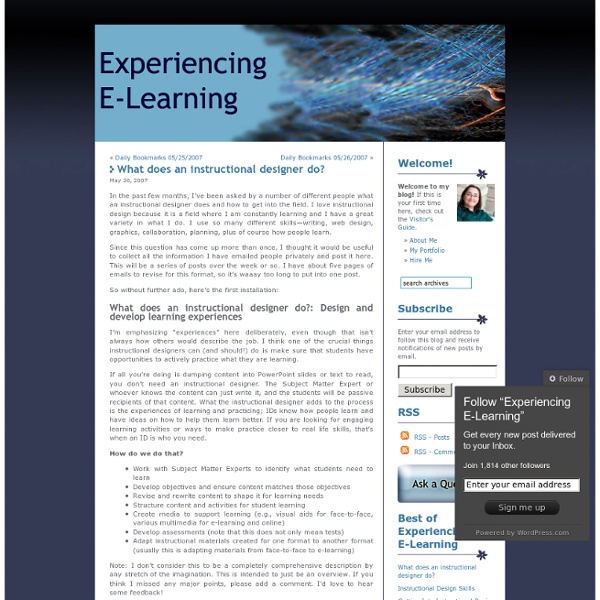Instructional Design
Table of Contents - 2011BestPractices.pdf
Instructional Design
Scaffolding helps to build a framework for the learners What is Instructional Design? Instructional Design is defined as “a systematic process that is employed to develop education and training programs in a consistent and reliable fashion” (Reiser, Dempsey, 2007). In addition, it may be thought of as a framework for developing modules or lessons that (Merrill, Drake, Lacy, Pratt, 1996): increase and enhance the possibility of learning makes the acquisition of knowledge and skill more efficient, effective, and appealing, encourages the engagement of learners so that they learn faster and gain deeper levels of understanding In a nutshell, instructional design can be thought of as a process for creating effective and efficient learning processes. While other models are aimed at specific learning processes, such as van Merriënboer's 4C/ID model, which is used when the learners must master complex problem solving. Differences Between Instructional Design and Instructional System Design 1.
Careers
Join a Team that Sparks Inspiration Promethean is a global education company that improves the quality of education by developing, integrating and implementing innovative 21st century learning environments that motivate students to learn. The company is headquartered in Blackburn in Lancashire, England, with U.S. headquarters in Atlanta, Georgia. As a global company, Promethean believes that diversity enriches our culture, the communities in which we live and work, and the lives of our employees. Diversity at Promethean is defined broadly to include group differences (age, national origin, race, religion, gender, ancestry, sexual orientation, disabilities, parental status, or job group, etc.) as well as individual differences, including communications style, educational background, career expectations and any of the numerous variables that can exist within any group of people. Ready to start your Journey? Apply Now
How to become an instructional designer
A lot of people ask me how they could become instructional designers. Here’s some advice from my perspective, followed by links for other perspectives. All of this applies to instructional design in the business world, not academia or K-12 education. Get experience in your current job The first step can be to get more instructional design experience at your current job, if possible. Another approach is to simply create what the organization needs, if you have the time. Another approach is to politely offer to overhaul an existing course or other learning intervention that isn’t working or that people complain about, even if has nothing to do with your job description. Build a portfolio A lot of designers create portfolios that show examples of elearning that they’ve developed. If you want to do instructional design, meaning you want to solve performance problems and not just be a course producer, be sure to explain the instructional decisions you made for each sample in your portfolio.
The Accidental Instructional Designer by Cammy Bean
“You may have found your way into this field by accident, but it is what you’re doing in the here and now, so you might as well do it well and with great passion and delight.” When you were a kid, what did you want to be when you grew up? A doctor? A teacher? A firefighter? As a teenager and young adult, I set my sights on becoming a writer or a teacher. Let’s get personal How did I get here? From there I went to a “multimedia production” company that hired me as an instructional designer. What about you? So what’s your story? As eLearning continues to grow and expand as an industry, we see more and more people finding their way into the field by accident. Kicking it up a notch So what can you do – for yourself and for your internal teams – to start creating better eLearning that actually achieves real performance change? You can do lots of things, but let’s start at the beginning. What’s the fire in your belly? First and foremost: Get your passion on. Make connections Read books.
Eesti Haridusteaduste Ajakiri. Estonian Journal of Education
Eesti Haridusteaduste Ajakiri. Estonian Journal of Education on eelretsenseeritav ja rahvusvahelise toimetuskolleegiumiga avatud juurdepääsuga ajakiri, mis avaldab eestikeelseid akadeemilisi originaaluurimusi ja teaduspõhiseid kaastöid kasvatusteadustest, haridusest ja õpetajakoolitusest kogu selle mitmekülgsuses. Ajakirja antakse välja Tartu Ülikooli ja Tallinna Ülikooli koostöös, Tartu Ülikooli Kirjastuse väljaandena ning avaldatakse avatud publitseerimise platvormil OJS (Open Journal Systems). Ilmumissagedus on kaks numbrit aastas (mais ja novembris ). Eesti Haridusteaduste Ajakiri. The journal uses Open Journal Systems (OJS) and will be published in collaboration with the University of Tartu and Tallinn University by the University of Tartu Press. The journal will be published twice a year (in May and November ). Announcements No 2(1) (2014) Table of Contents Eessõna / Preface Artiklid / Articles Raamatututvustus / Book review
Raising the Floor Home Page | Raising the Floor
10 Qualities of the Ideal Instructional Designer
Sharebar People employed as instructional designers come from wildly varied educational backgrounds. I’ve met writers, teachers, media specialists, psychologists and programmers who somehow have ended up designing web-based and instructor-led courses. For the past several years, blogger Cammy Bean has had an open survey asking her instructional design readership whether they have a degree in instructional design. Although the survey doesn’t use a scientific sampling method (basically, whoever happens upon the survey can respond), the results cannot be ignored. The survey results are no longer available, but in 2009, these were the results: ~ 60% do not have a degree~ 38% have a graduate degree in Instructional Design~ 1% responded that they have an Instructional Design degree (level is unspecified) Do Instructional Designers Need a Degree? There is an ongoing debate within the US instructional design community as to whether a degree is needed to be most effective in this field. Top 10 List



